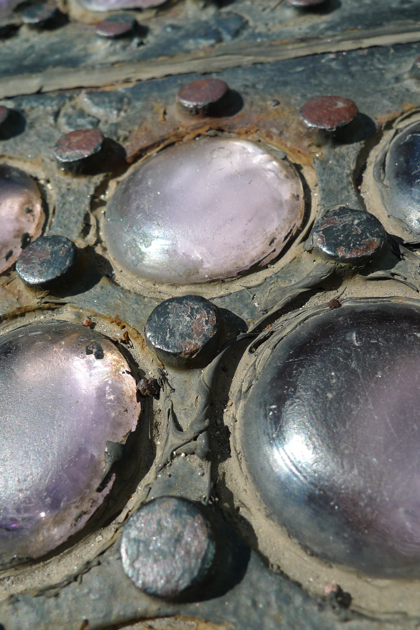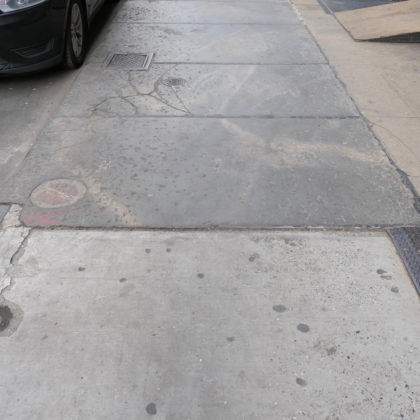Protect Our Sidewalks and Vault Lights
 The Landmarks Preservation Commission’s proposed streamlining of its processes includes two changes, regarding sidewalks and vault lights, that have major ramifications for Tribeca. As the Historic Districts Council explains in its testimony to the LPC (h/t TreeHugger):
The Landmarks Preservation Commission’s proposed streamlining of its processes includes two changes, regarding sidewalks and vault lights, that have major ramifications for Tribeca. As the Historic Districts Council explains in its testimony to the LPC (h/t TreeHugger):
Page 89 (3): This section stipulates that if a sidewalk is missing some of its bluestone pavers or some of them are beyond repair, an applicant may consolidate the usable bluestone and install tinted concrete pavers in the remaining area. Bluestone or granite curbs in need of repair may also be replaced with concrete. Pavers and curbs in historically accurate materials like bluestone and granite contribute to the special character of those historic districts that feature them. Why should the LPC staff not encourage their replacement in-kind, rather than allowing for banal concrete in their place? This rule would short-change our historic districts and remove all incentive for applicants to ever replace in-kind. Looking into the future, as these historic materials inevitably deteriorate, and if this rule change goes into effect, historic paving will become a thing of the past.
Replacing bluestone and granite with concrete would be a shame. You may not realize how much such things add character to this neighborhood. And then there’s this, about our beloved vault lights—the little round pieces of glass embedded in the sidewalk to let light into basements:
Page 91 (2-3): Vault lights are a defining feature of former manufacturing districts like SoHo and Tribeca, providing evidence that these districts were once industrial powerhouses, as opposed to the domain of wealthy property owners, shoppers and tourists that we see today. This rule change states that the staff will approve the removal of up to two panels of exposed vault lights that are deteriorated beyond repair if no other vault lights exist on the same side of the block. They may be replaced with diamond plate steel or concrete/granite to match the adjacent sidewalk. For covered vault lights that are deteriorated beyond repair, applicants would now be given the choice to replace them with new vault lights or remove them altogether. Similar to the issue of replacing bluestone pavers with concrete, this would remove all incentive for applicants to replicate this historic detail. Further, given the cost differential between vault lights and diamond plate steel, the public would now have to rely only on the owner’s discretion to safeguard this feature. HDC believes this should fall within the mission of this public agency.
Amen! (If you’re not sure what diamond plate is, please click that link above.) Why does the LPC exist if not to protect something like vault lights? They’re the very essence of historic New York City. “Materials on a historic building are meant to last a long time, and inappropriate replacement materials can mar a structure for decades,” notes the HDC. “It is imperative that the LPC requires the highest standard if it plans to forgo the expert and discretionary guidance of the Commissioners.”
Unfortunately, the LPC hearing about this is tomorrow, March 27, at 9 a.m. (on the 9th floor of the Municipal Building at 1 Centre St.).














LPC’s rules are vital to maintaining the integrity of the buildings that are individual landmarks and those that comprise the historic districts. Putting aside tear-downs, we have all seen the negative effect of the ghastly renovations of some historic buildings located just outside the historic districts. (ahem, 365 Broadway, ahem)
That said, HDC’s misuse and abuse of the word “incentive” here reveals a lot about their thinking. HDC wrote, “For covered vault lights that are deteriorated beyond repair, applicants would now be given the choice to replace them with new vault lights or remove them altogether. Similar to the issue of replacing bluestone pavers with concrete, this would remove all incentive for applicants to replicate this historic detail.”
“Incentive” is defined as “something that incites or tends to incite to action or greater effort, as a reward offered for increased productivity.” It is fine to have rules, but let’s not pretend that these rules are “incentives” when they are not.
LPC’s rules are just that–rules. Despite what HDC writes, there are no “incentives” to follow the LPC rules. There are no choices. The rules are mandatory, obligatory, and compulsory. One ought to know that going in when getting involved with a building in a landmark district. There is no reward, other than the aesthetic and psychic utility, for an building owner who spends vastly greater sums on bluestone or replica glass lights than on tinted concrete or diamond plate, respectively. It is very complicated and expensive to re-use, repair, and maintain historic buildings without drawing a practical line somewhere as to what items must and must not be replicated. (Further, bluestone sidewalks and cast iron glass lights were originally abandoned as technologies–in favor of concrete sidewalks and electric lights–in part because they did not wear well and were hard to maintain properly.)
If anything, these rules are DISincentives, and these disincentives minimize the common reward that neighbors enjoy from their neighbors’ landmark renovations. These rules, and many others like them, discourage proper maintenance and repair of historic buildings by larding on all kinds of additional costs onto projects for replica versions of historic materials, many from a few specialty low-volume manufacturers whose products do not always match the historic versions well. (Those added hard costs are on top of the added soft costs in working on landmarked buildings. These include the delays and repeated resubmissions that are inherent in applying to LPC approval. Other portions of the proposed rules are trying to address those issues and standardize the process and the criteria.) The only “choice” is not to postpone the work or just not do the work.
About 4% of landmarks are individual landmarks, that is, landmarks that are landmarks not be virtue of being located within a historic district, but because of their individual historic significance. LPC has no control over the sidewalks adjacent to individual landmarks, yet these buildings maintain their historic significance.
Finally, new buildings constructed in landmark districts use modern materials all the time, whether concrete sidewalks, metal windows, manufactured brickface, etc. Why not mandate that these buildings be built the way buildings were built over 100 years ago, using bluestone sidewalks, wood windows and bricklayers to set individual bricks?
There are often many financial rewards actually
This is surprising indeed.
Another factor which degrades our neighborhood (and the city at large), as indicated in the photo: the gum stains. Gum is often just discarded right onto these historic stones, and even on the metal plates with glass. It would be wonderful if NYC actually enforced anti-littering laws. Of course, it’s not just gum: it’s cigarettes, fast-food trash, etc. Our super cleans up in front of our building twice a day but can’t keep up. I’m always cleaning up the debris of inconsiderate persons in the times between. It’s really a shame.
After years of research and due diligence our building in NW Tribeca recently restored the original Jacob Mark vault lites with the approval of LPC. Now LPC is contemplating loosening their position on the integrity of these restorations? For more info on vault lites, a part of Tribeca’s history: https://www.waltergrutchfield.net/mark.htm
James makes legitimate points that ring true.
If the City feels like the historic character of these districts is a public good, then the City should actually provide proper incentives to make real improvements with reasonable set standards. City can provide incentives via RE tax abatements, and if coordinated properly can grow the historic preservation industry In general, thereby growing that sector of skilled labor and also fostering a better, and more financially feasible way, to restore buildings.
I love my Vault lights, and so do many who have taken pictures of them. I agree it maintains the charm of the hood. Reality is do to age, they leak, high heels pop them out, and the cost to replace them or the complete panel are crazy numbers. A incentive would be a grant to help frey the cost of maintaining the lites.
I would love to get my hands on any old lights so I can replace the current missing ones.
As for the granite slabs: These are long and thick and with time has little holes in them from days gone by, I think from the salt put done or chemicals used. To replace these slaps all 20 is beyond the budget. currently they are strong, but is one ever fails, concrete it will be.
Any updates on these rules?
Vault lights are indeed very expensive to replace or maintain. On our street they take a lot of abuse from the delivery carts. Many are cracked.
It’s not just the glass lenses themselves. Water infiltrates around the glass. Also, the metal frames are usually cast iron. Water on horizontal cast iron will sit and rust it out, unlike vertical cast iron columns which will better shed the water.